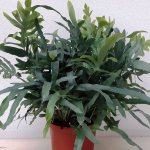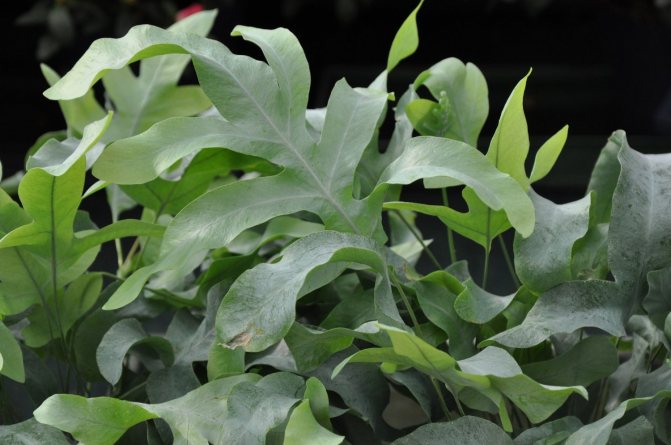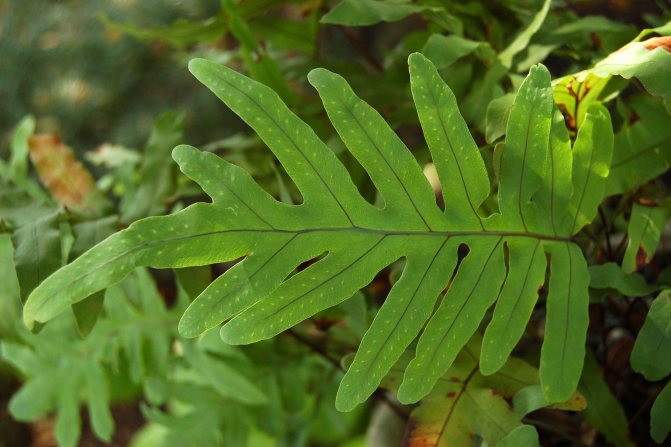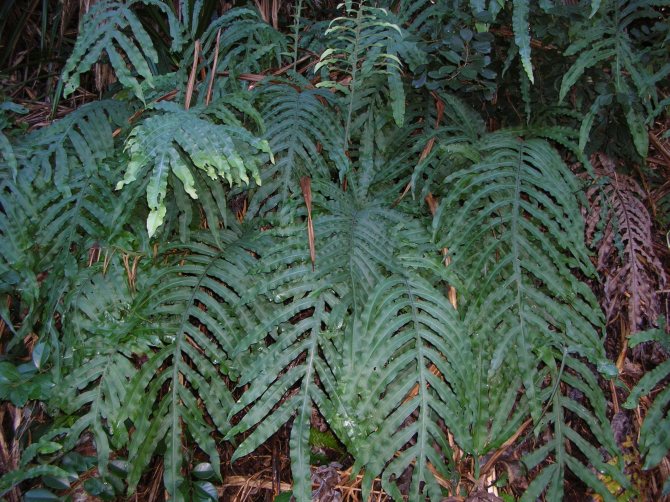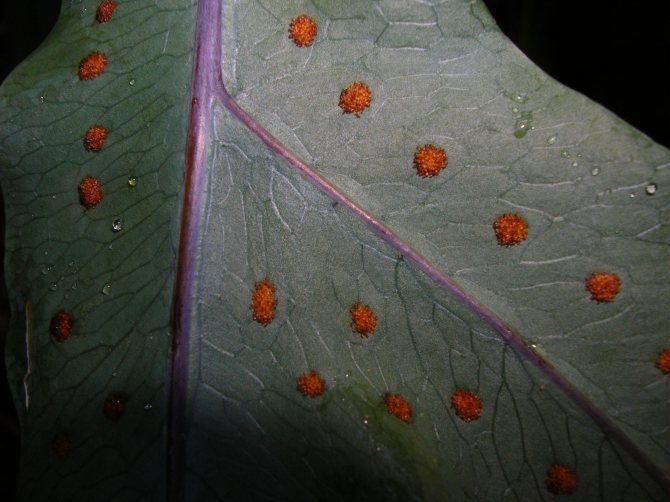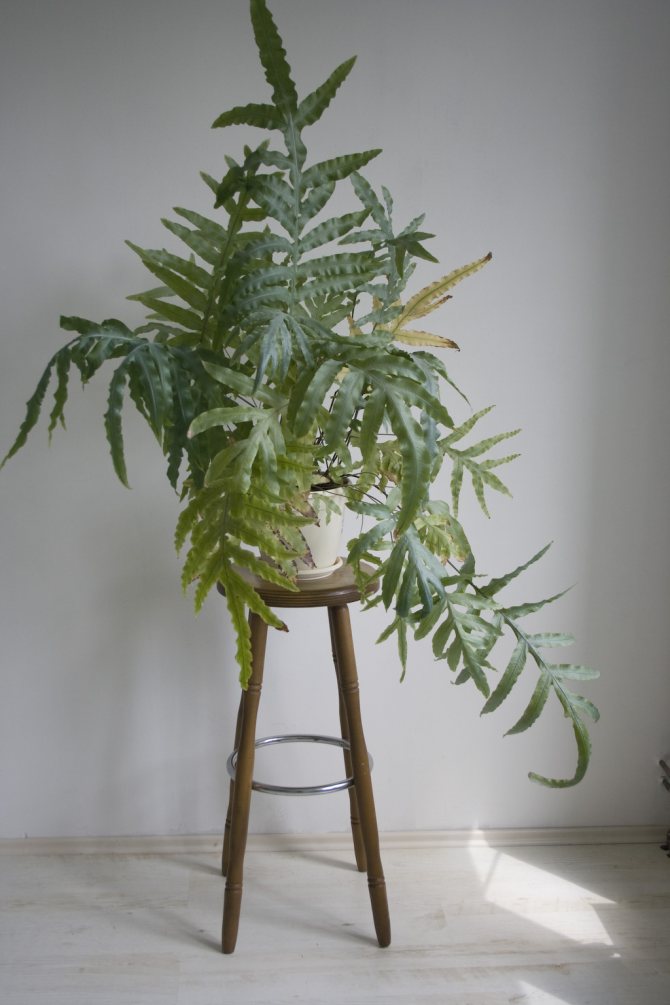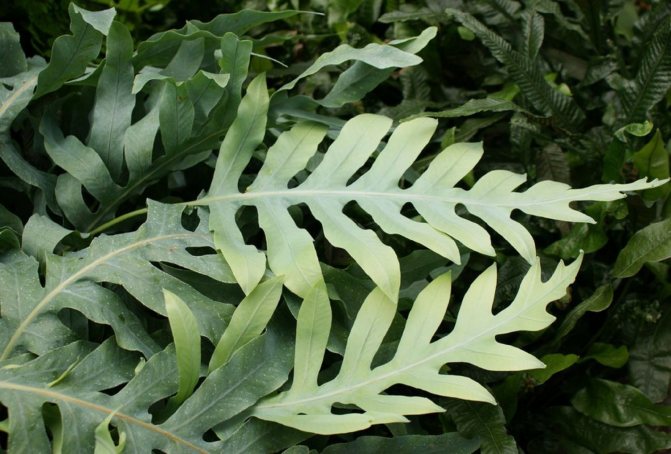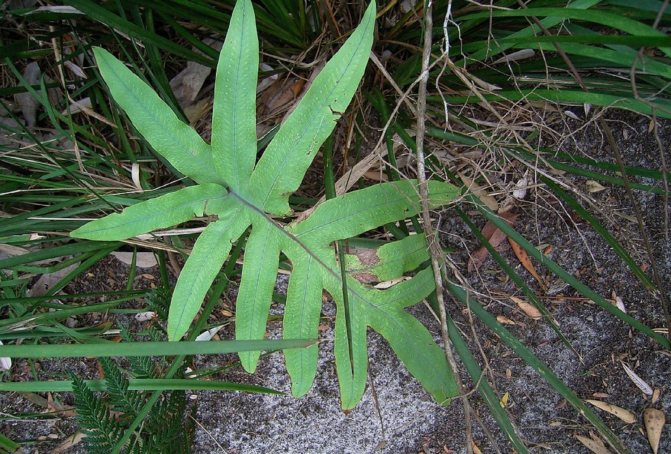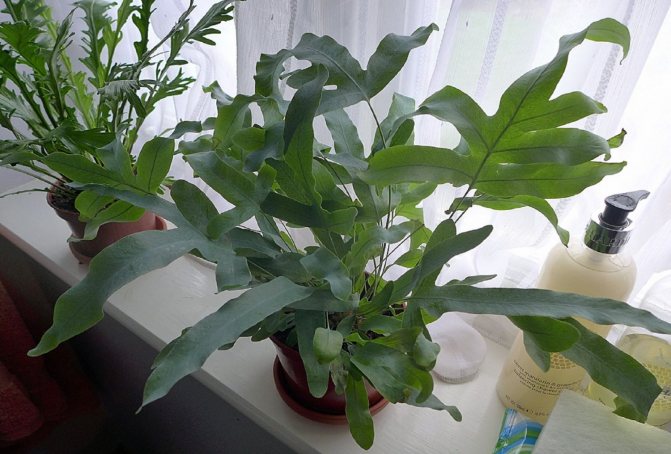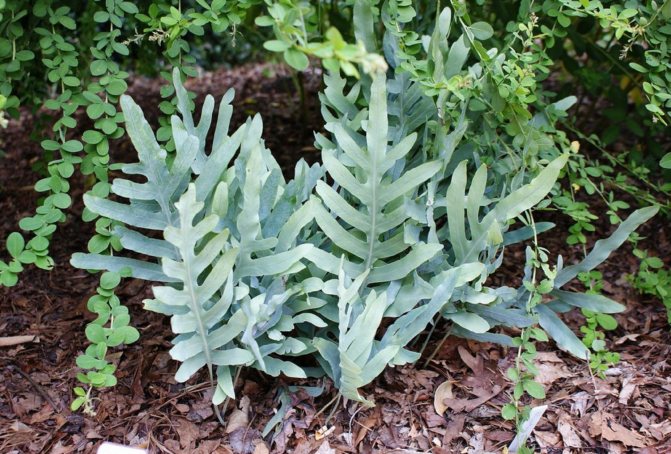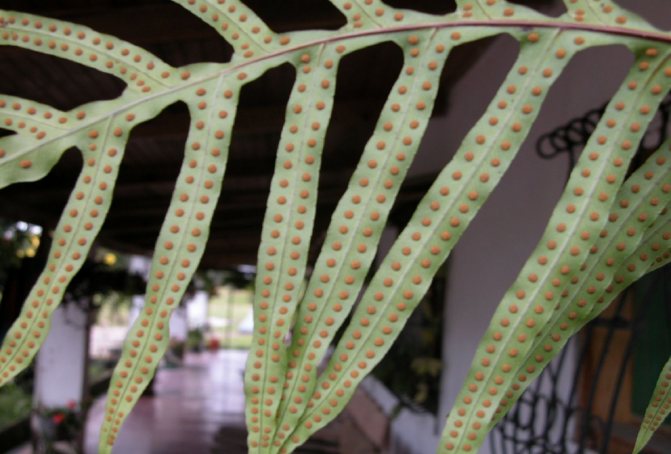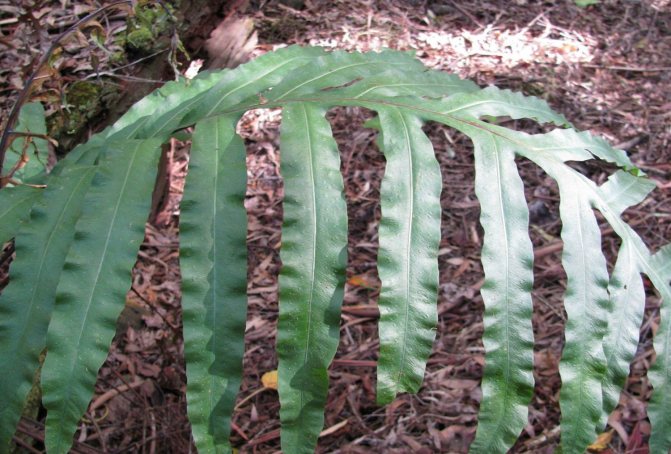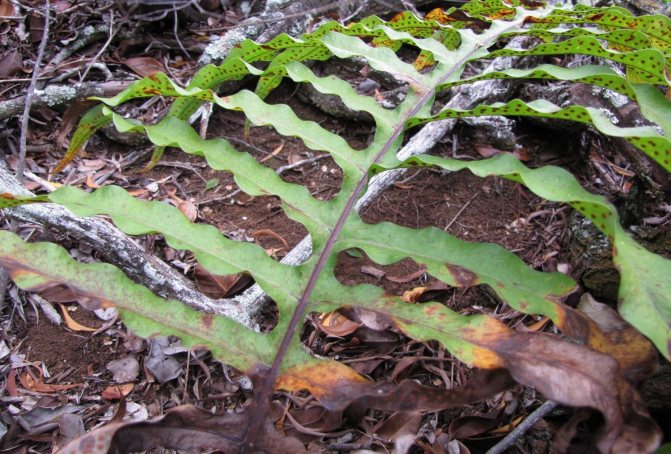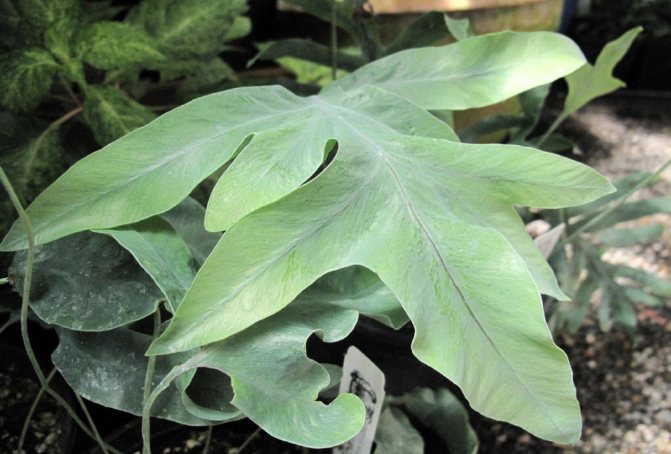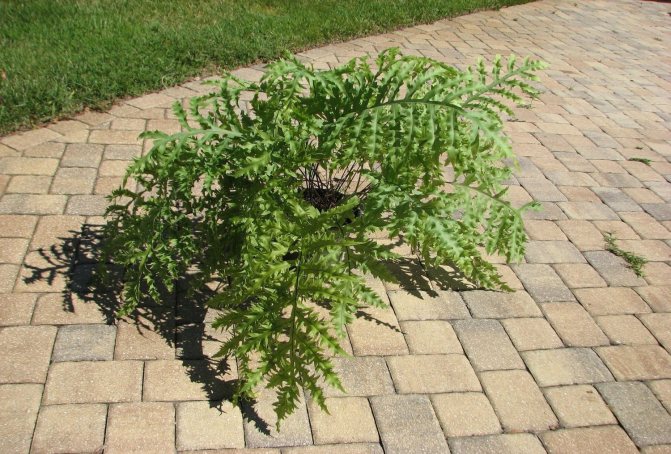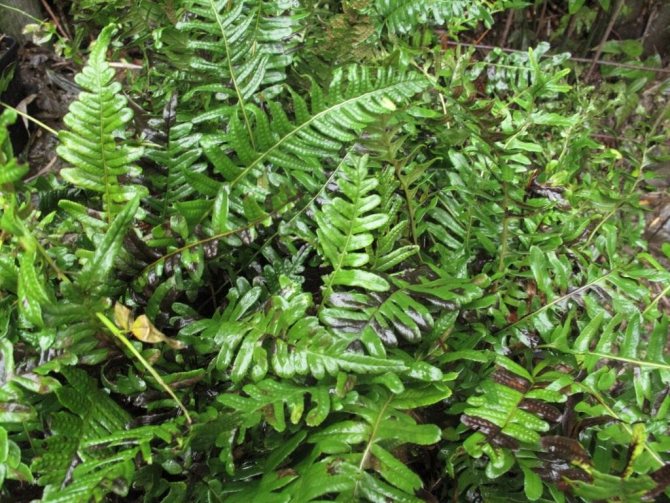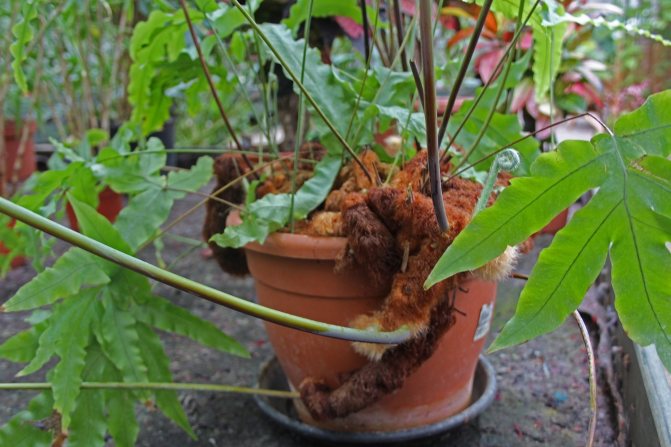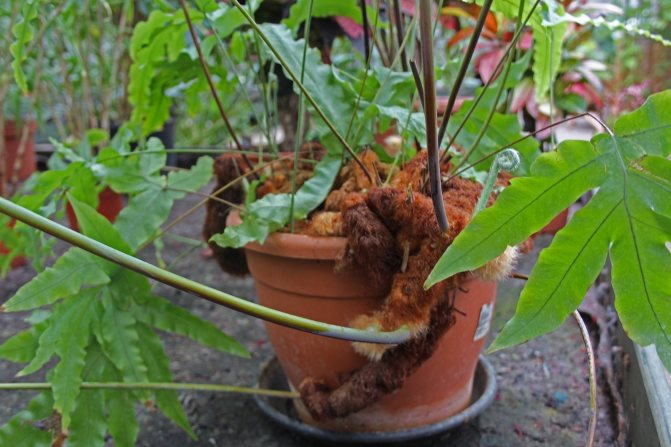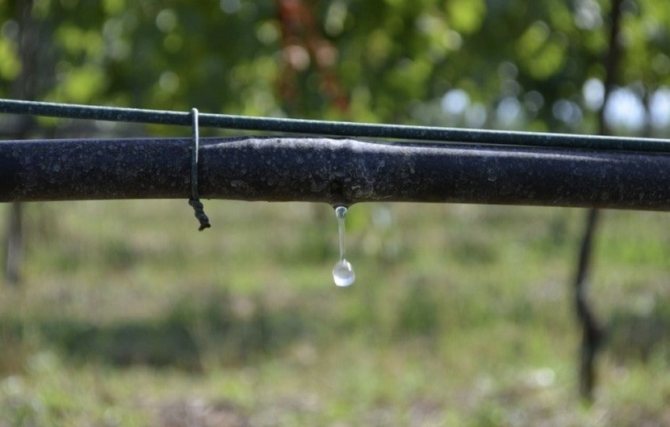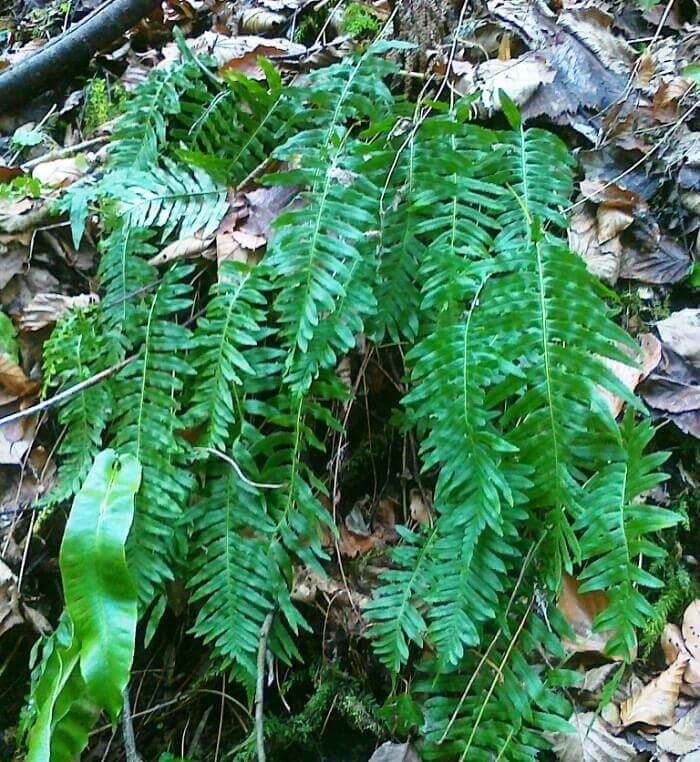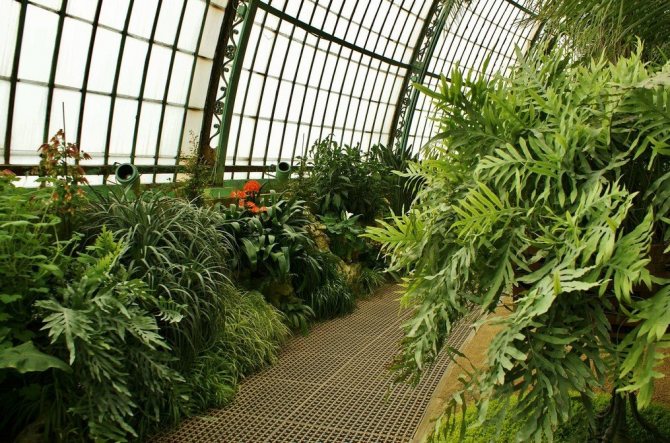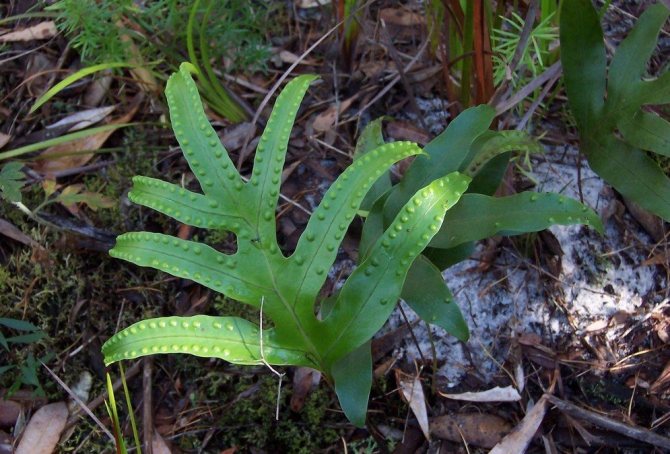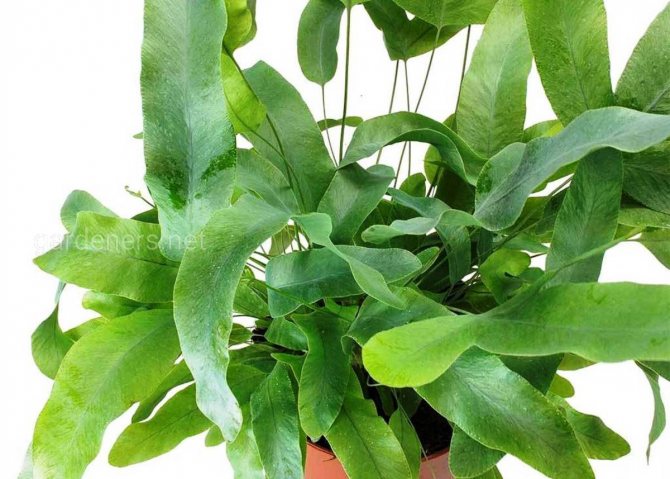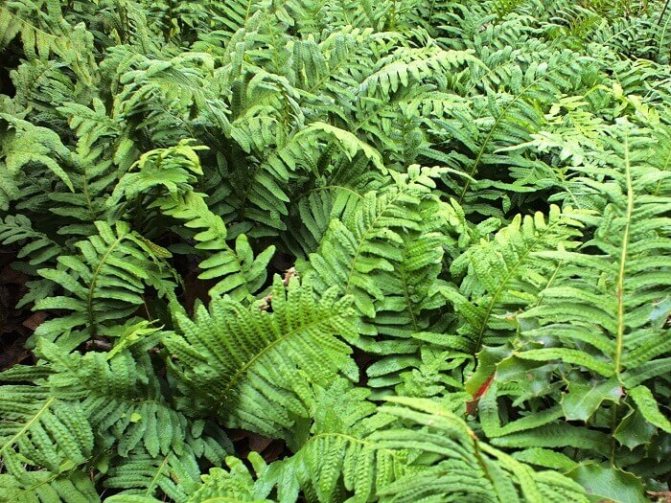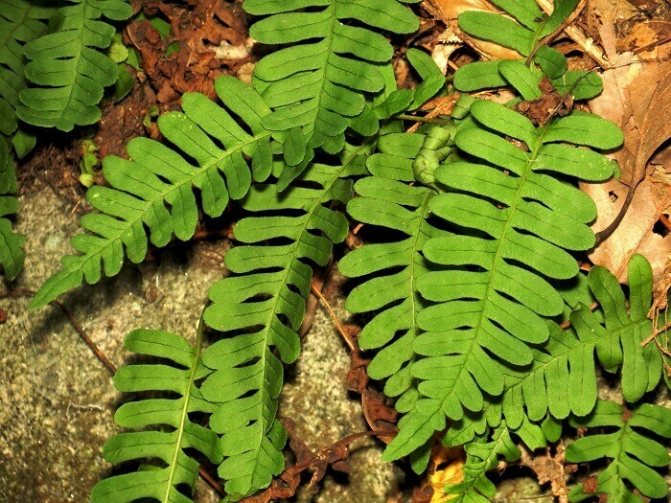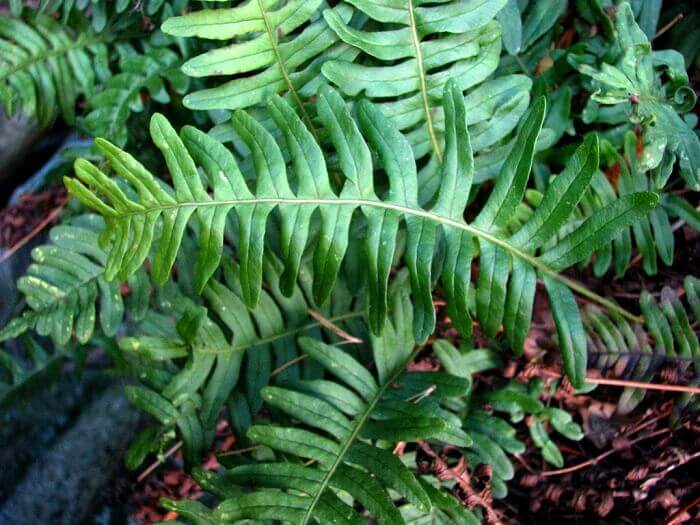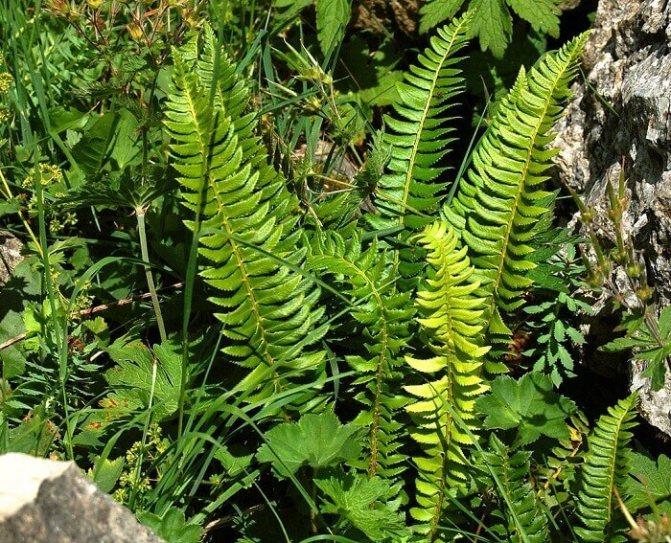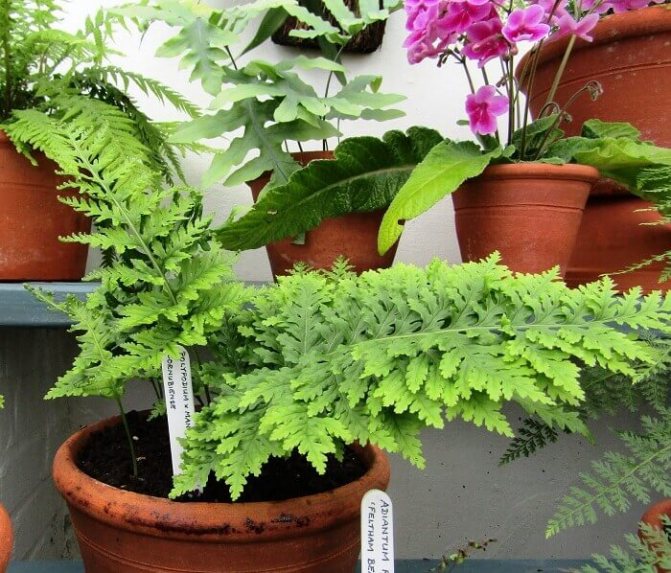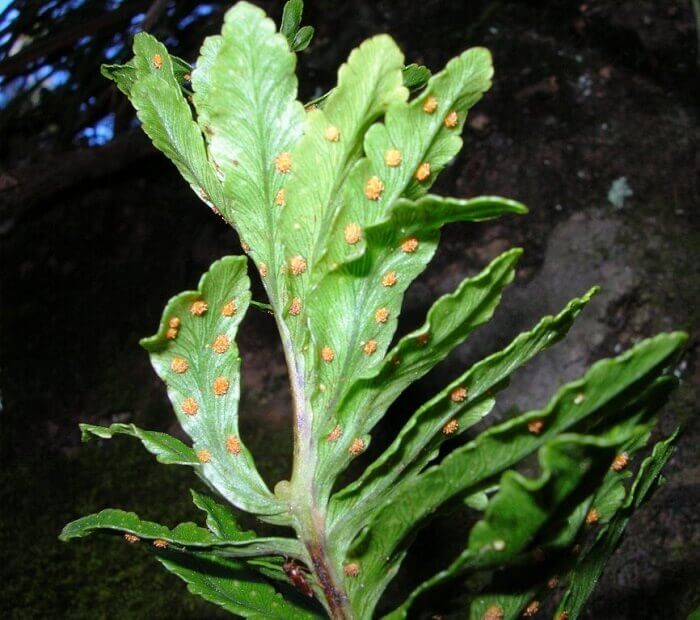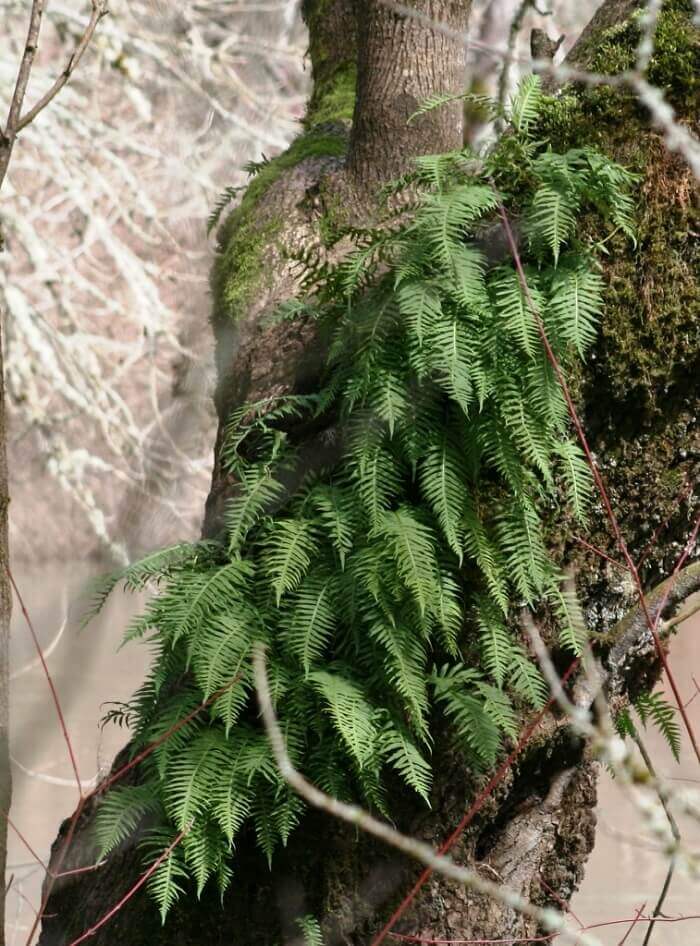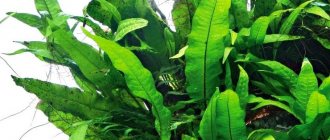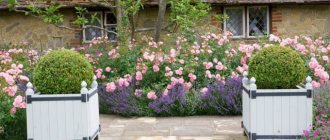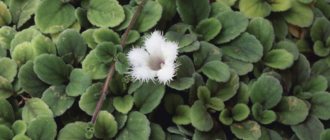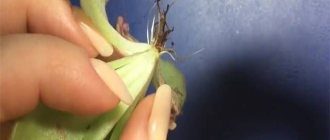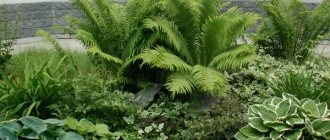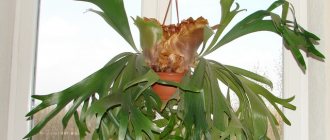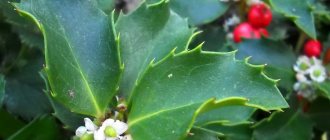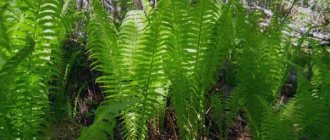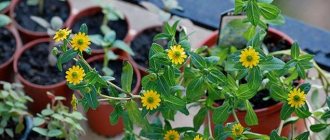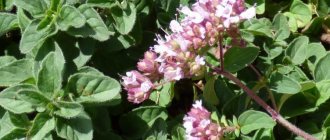Growing ferns in indoor culture began in the Victorian era. It was then that they became a fashionable decoration for salons and winter gardens in noble houses, and then in elite hotels and other public places. In our time, this tradition has not been lost, but on the contrary, it is gaining more and more popularity. In the interiors of offices, in apartments of residential buildings, you can now see the golden phlebodium (Phlebodium aureum), as well as its varietal varieties. The most available on sale:
- ‘Mandaianum’;
- ‘Ekstrand’;
- ‘Blue star’;
- ‘Undulatu’;
- ‘Glaucum’.
More recently, the genus Phlebodium was separated into a separate one from the genus "Centipede" (Latin Polypodium), which is a member of the large family "Centipede" (Latin Polypodiaceae). Therefore, in the catalogs of gardening companies and flower shops in the names of phlebodium varieties in the old fashioned way, the former genus name - Polypodium or the common name of the family - Centipede is often present. The main decoration of these ferns is emerald-bluish and greenish-silvery frond with comb or wavy edges. They look wonderful against the background of thick rhizomes covered with soft golden scales. An important fact is the unpretentiousness of plants to care and high adaptation to room maintenance.
general description
Depending on the growth zone, ferns of the Polypodium species are evergreen or deciduous. All varieties are characterized by a thick rhizome spreading along the ground, covered with numerous scales.
Two rows of leathery carved leaves grow from it on long stalks, which, dying off, leave behind scars similar to legs.
For this feature, the plant got its name - in translation it means "many legs".
The bright green of the fern is very diverse. Leaves or fronds can be whole, pinnate or double-pinned.
There are specimens with miniature foliage no more than 10 cm in length and huge sprawling representatives of the flora with half-meter fronds.
On the lower part of the leaf plate, rounded outgrowths of yellow-orange color are observed - these are sporangia that form spores. In an apartment, the polypodium rarely spores. Some varieties of the millipede have recently been attributed by botanists to its closest relative, the Phlebodium genus.
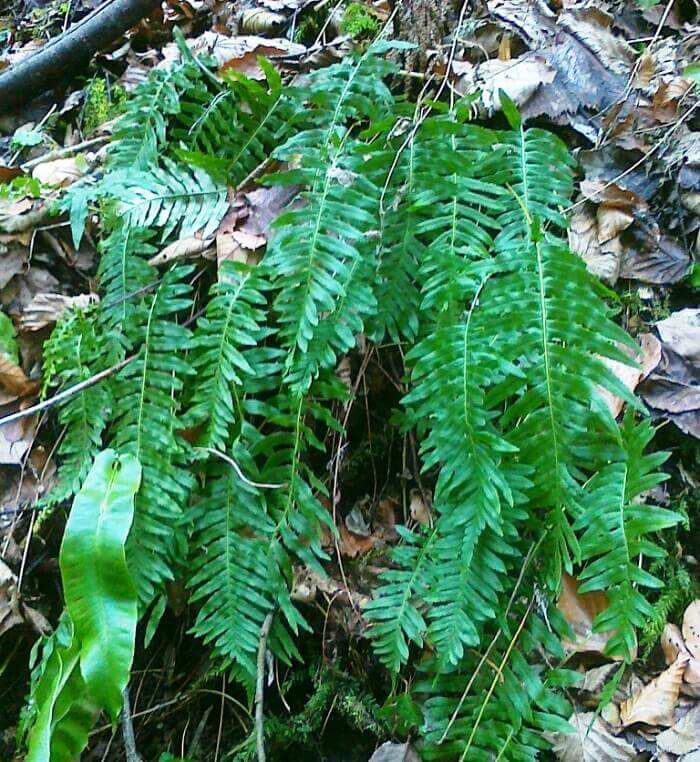
With proper care, the polypodium lives in an apartment for many years, releasing several new leaves annually. It looks very impressive in floor and hanging flowerpots. It is a luxurious decoration for apartments, balconies, conservatories and home greenhouses.
Polypodiums, which are also called millipedes, are epiphytes or herbaceous plants with creeping rhizomes covered with scales. They can be either evergreen or deciduous, depending on where they grow. Epiphytes grow on tree trunks, rocks covered with moss, in rock crevices, and ground ones grow in wet lowlands.
Fronts on long petioles emerge from the upper part of the rhizome and can be pinnately dissected, whole or double-pinned. Dying off, they leave outgrowths on the petiole that look like legs. The leaf plates are bare, bright green in color, their size, depending on the type, ranges from 10 cm to half a meter.
Large round sori have no vellum and are arranged in rows on the underside of the leaf or at the ends of the leaves.
Economic value and application
Ornamental plant
Used in decorative landscaping in the interior. In winter, it is kept at a temperature not lower than 18-20 ° C. Temperatures below 5 ° C are fatal for him. The plant is shade-tolerant. Drying out of the substrate is undesirable. The substrate is loose, neutral, with an admixture of coniferous soil.
Several garden varieties have been bred, with leaf colors ranging from gray-green to silvery-green to bluish-green, as well as comb-like or very wavy leaf edges.
In folk medicine
A decoction from this plant is used as a panacea in traditional Central American medicine. It has been used against a wide variety of diseases ranging from asthma to heart disease. Its close relative, the common centipede (Polypodium vulgare
), was used in Europe until the Renaissance for cough and mental health problems. The Mayans began using phlebodium golden as a tea to purify the blood, and this practice continues in Honduras now. To: Wikipedia: Articles without sources (type: unspecified) [
source not specified 2606 days
]
It has shown itself to be an effective immunomodulator when administered orally (selectively modulates overactive immune cells), as well as an antipsoriasis, neuroprotective (protects brain cells), antitussive, anti-inflammatory and UV-protective agent [2] [3] [4] [5] ... In Europe, it has been widely available as a drug since 1892, and there have been no cases of poisoning since then, although it may potentiate the effect of digoxin heart medications. K: Wikipedia: Articles without sources (type: not specified) [source not specified 2606 days
]
Thus, it applies:
| Check information. It is necessary to verify the accuracy of the facts and the accuracy of the information presented in this article. There should be explanations on the talk page. |
- against psoriasis and other skin diseases; K: Wikipedia: Articles without sources (type: not specified) [source not specified 2606 days
] - against Alzheimer's disease, dementia and memory problems; K: Wikipedia: Articles without sources (type: not specified) [source not specified 2606 days
] - for coughs, bronchitis, hypothermia of the chest and other respiratory diseases; K: Wikipedia: Articles without sources (type: not specified) [source not specified 2606 days
] - for autoimmune diseases. K: Wikipedia: Articles without sources (type: not specified) [source not specified 2606 days
]
There are reports that its use has helped with multiple sclerosis and vitiligo. K: Wikipedia: Articles without sources (type: not specified) [source not specified 2606 days
]
Invasiveness
The species can be invasive as it spread extremely quickly in Hawaii after 1910.
Reproduction of polypodium
It is difficult to propagate this fern by disputes even for experienced flower growers. It is best to divide the rhizome when transplanting, cover the new plant with a film and for the first time keep it in a shaded place at high temperature and humidity.
By dividing
The rhizome of a healthy adult plant is cut into 2-3 parts so that a few leaves remain on each of them. The slices are sprinkled with wood ash. Delenki are planted in a substrate, covered with a plastic bag and placed in a warm and shaded place for a week.
Disputes
This is a rather laborious and complicated method. After the sporangia turn brown, they are cut with the leaf, placed in an air-permeable bag and hung to dry.
After 7-8 days, spores will begin to sleep. For their germination, a mini-greenhouse with bottom heating is used. Clean brick is placed in the container, and wet peat is placed on top of it. Next, distilled water is poured, filling the container by 5 cm.
Spores are scattered on the surface of the peat, the crops are covered with a plastic lid or glass and placed in a shady place. At the same time, the amount of water in the container is always kept at the same level. After several months, greenish moss will appear on the surface of the substrate, and then the first leaves.
Growing
The root system of Phlebodium is extensive, but superficial. For its cultivation, shallow, spacious containers are used, which allow the fast-growing fern to do without transplanting for a long time. The procedure for moving to a larger container or dividing a bush should be done very carefully. Ferns of this genus tolerate it painfully and in the period after transplantation require increased attention. At the same time, the plants need abundant watering without waterlogging. Frequent regular feeding, about once every two weeks, will help to recover from stress after an unpleasant procedure for the fern.
Watering and feeding
Fern grows intensively in spring and summer. It is watered with soft water or room temperature water that has settled for several days. The plant tolerates slight drying of the soil (top layer), but in general, the earthen lump should always remain moist. This should be especially carefully monitored in the summer and during the growth of young wai.
It is necessary to ensure that water does not fall on the rhizome, otherwise, over time, an ugly limescale will form on the scales.
During the growing season, twice a month, they are fed with fertilizer for decorative leafy plants, reducing the concentration by half compared to that recommended on the package. In winter, feeding is stopped.
Soil and fertilizers
Phlebodium is transplanted annually at the beginning of their growth. Older instances need this update less frequently.
Fern containers are selected shallow and wide, which will allow the root system to be more freely located inside. The peculiarity of the transplant is to leave free space for the growth point of the rhizome itself.
For this process, a soil composition is selected that has a neutral or slightly acidic reaction and medium-dense in consistency. For this they prepare:
- sod land (1 part);
- sheet land (3 parts);
- sand (1 part).
At the bottom of the pot for Phlebodium it is necessary to arrange good drainage, which will help to regulate the level of soil moisture in time.
Fertilize Phlebodium universal organic or complex mineral fertilizers. The dosage is selected relative to the one recommended by the manufacturer. Top dressing is applied at intervals of once every three to four weeks.
Pests, diseases and possible difficulties
Enemies of the polypodium
Scabbard - brown insects on stems and leaves, sucking out cell sap, which makes them brighter, dry up and die off. Control measures: treatment with "Aktara" or "Aktellik".
Spider mite leaves behind, as if punctured by needles, greenery and cobwebs. Control measures: removal of pests with a soapy sponge and treatment with insecticides.
When over-watered, the centipede is susceptible to root rot. If such a nuisance occurs, the diseased roots should be removed, the cuts should be sprinkled with ash and the plant should be transplanted into new soil.
Possible problems
Leaves turn yellow and die - excess moisture, low humidity in winter or too little light; dry tips of leaves - insufficient moisture or irregular watering.
Leaves wilt and become translucent - too much sun. Vaiyas turn yellow with the formation of brownish spots - too hot in the room.
The leaves fade and the fern does not develop well - the pot volume is too small or too large, the lack of nutrients.
Fronds turn brown, curl and fall off, fresh leaves wither - drafts, high temperature, watering with hard or cold water.
- If pests appear, treat the plant with an insecticide.
- With a lack of moisture in the soil and air, the tips of the leaves dry out.
- Excess or lack of light causes growth retardation and yellowing of the leaves.
- With a lack of nutrients, the leaves turn pale and grow poorly.
Features of home care
Watering and humidity
In winter, it is advisable to locate the polypodium far from heating appliances, as well as protect it from drafts. Part of the leaves may turn yellow and fall off due to a noticeable lack of lighting at this time of the year. In early spring, yellow spores appear on the back of the leaf blade. However, growing young plants from them is quite troublesome and unnecessary, because phlebodium can be easily propagated by dividing the rhizome in large specimens. When purchasing this luxurious plant, take care of its future location in advance: the fern is relatively large.
The meaning of phlebodium in the house
Ferns, phlebodium are no exception, are considered mystical plants with magical properties and influence on human energy. Therefore, some lovers of indoor plants are afraid to keep them in their home. Indeed, allergy sufferers may experience malaise from the pollen that scatters from fern spores during their maturity periods. In all other respects, it is better to rely on the old belief that ferns, with their grace and beauty, bring spiritual harmony into the house, and with their mysterious energy they protect the home from evil evil spirits.
Photos of polypodium
| Polypodium golden | Polypodium golden | Polypodium golden |
| Pachystachis Pachystachys is an evergreen perennial shrub brought from the tropical rainforests of Central and South America. It is also home to the subtropical forests of East India, the coast of Australia. |
| Pelargonium I have been friends with flowers for a long time, since childhood. I have a lot of them growing - both in the open field and in the house. There are time-tested favorites and newfangled exotics. But I want to tell you about one flower, which my daughter calls her grandmother's. This is pelargonium, geranium, kalachik ... |
| Platizerium It can also be grown in traditional potting culture, especially young plants. But really impressive and, importantly, naturally, the fern will look in a hanging planter or basket. |
What you need to know about planting a polypodium
Before planting a polypodium, you need to think about the conditions of detention and the choice of a place for the plant. The fern differs from ordinary flowers not only in the absence of peduncles and buds, but also in the structure of the crown and roots. That is why we will talk about choosing the right pot for planting, selecting the soil and placing the flowerpot in the house.
Did you know? Polypodium got the name "centipede" because of the row arrangement of leaves that resemble thin legs.
Choosing a container for growing polypodium
Let's start by choosing the right vessel for the fern centipede. When buying a fern in a pot, you should find out how old the plant is and how much it is in a given container.
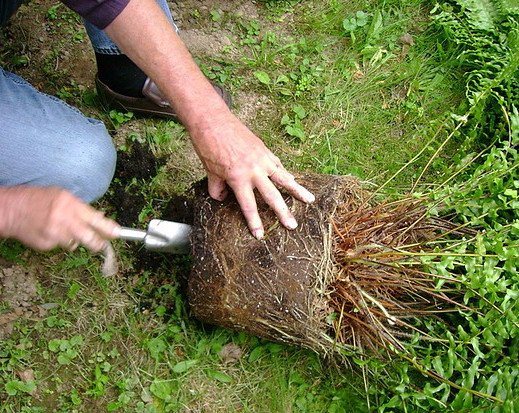

After purchase, in any case, the fern must be removed from the pot and inspected the roots.
If the volume of the roots is equal to the volume of the pot, then it is better to transplant it into a new one. Since the root system of the polypodium is strong enough, in the absence of free space in the vessel, the roots will simply break through the plastic pot or begin to "crawl" out of the soil.
You only need to select a pot in accordance with the size of the roots. In this case, preference is given to low, wide vessels that have a large bottom area. In such a pot, the root system will be in a natural (natural) position, and the roots themselves will grow in breadth.
Important! Bulky roots will not be able to grow in a very elongated narrow vessel, so choose a pot that is round or square.
It is recommended to buy a vessel made of strong materials (clay, earthenware, porcelain, marble) in order to prevent deformation of the pot due to the pressure of the root system.
How to choose a place to grow
Polypodium loves diffused light, so when choosing a place for growing, you must immediately cross out open balconies and southern windows.
It is best to place the flowerpot on the east side. The northern part of the room is also a good option. The main task is to exclude direct sunlight on the fern leaves. As a last resort, you can place the flower on the south side, but at the same time you need to shade well the location of the flowerpot.
In winter, the fern requires good lighting (since in its homeland there is no winter as such). The duration of daylight hours should be at least eight hours. Additional lighting is provided by fluorescent lamps, which are placed at a distance of 50-70 cm from the plant.
Important! Particularly dangerous for the fern are the midday rays of the sun, which in a matter of hours "burn" the leaves and can lead to the death of the flower.
Planting advice: choosing soil for polypodium
The polypodium fern loves slightly acidic loose soils, which can be purchased at a flower shop or made yourself. The best option is to “prepare” the substrate at home, as you will know for sure that the soil does not have harmful impurities.
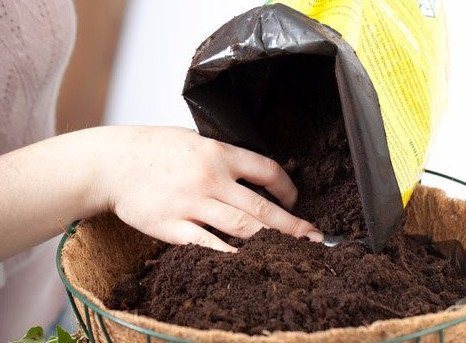

For the preparation of the soil, a mixture of crushed pine bark, sphagnum and leaf humus in equal proportions is used. This is the ideal soil composition, but the required constituents cannot always be found. Another option for the substrate involves the use of coniferous land, leaf land, peat, humus earth and sand in a ratio of 1: 2: 1: 1: 1.
Before loading the substrate into the pot, drainage from expanded clay or small pebbles must be laid on the bottom. Although the soil has good drainage properties, additional moisture removal never hurts.
In the event that the soil cannot be prepared at home for any reason, try to find a special substrate for ferns or epiphytes in a flower shop. Such soil will have all the necessary properties to ensure the normal growth and development of your pet.
Important! The use of clayey or heavy soils is strictly prohibited due to moisture retention. Such soils will cause root rot.
Popular types
The phlebodium fern is represented by four species and several decorative varieties. The most widespread phlebodium golden... The plant is so named for the golden covering of the rhizome. At the very ground there is a dense rosette of long leaves. An adult leaf reaches a length of 1 m. On a rigid, long petiole, there are deeply divided narrow lobes of a green-blue or dove-gray color. On the edge of the lobes on the back side there are bright yellow rounded sporangia.
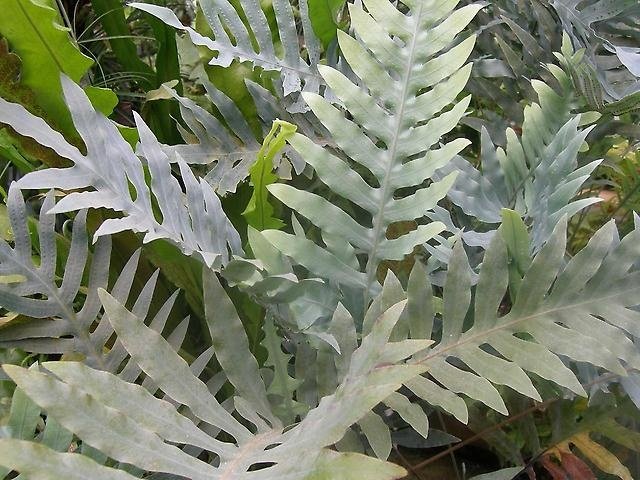

Phlebodium golden
Phlebodium is false gold. The foliage is more dense and dark or bluish in color. Sporangia are arranged in one row along the central vein.
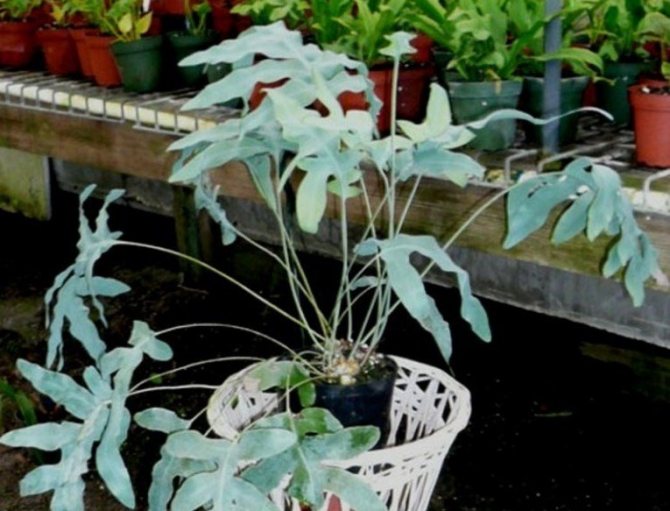

Phlebodium false gold
Phlebodium is pimply. The bush is distinguished by long, pinnately dissected leaves of a bright green color. Thin, leathery lanceolate leaves have a shiny surface. Rounded sporangia are located along the lower edge of the lobes.
Radermacher: photos and species, reproduction and care at home
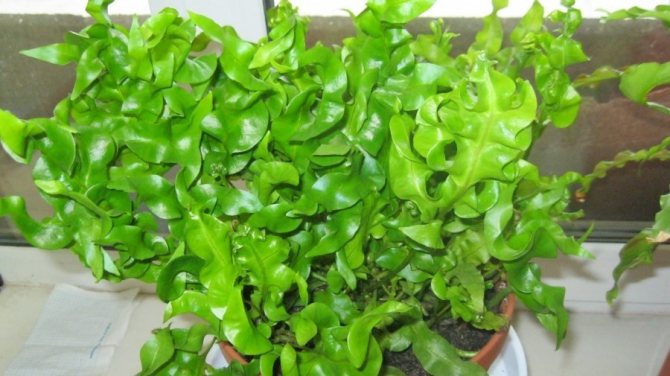

Phlebodium pimpled
Phlebodium decumanum. The plant forms a large spreading bush 1-1.2 m high. The fleshy orange rhizome is partially located on the soil surface. The dark green glossy foliage is divided into uneven parts. Teardrop-shaped orange sporangia are located in 3-7 rows on the reverse surface of frond.
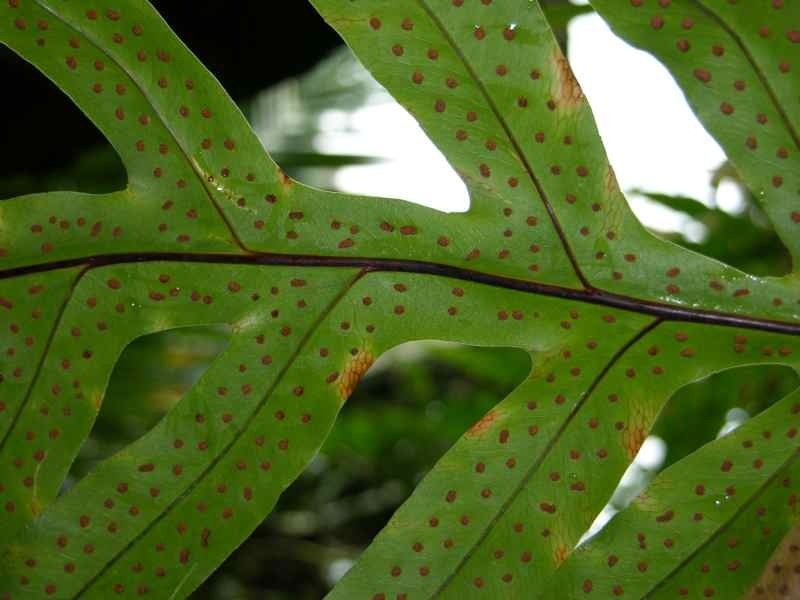

Phlebodium decumanum
Decorative varieties:
- Mandaianum - large unequal leaf lobes have a wavy edge;
- Ekstrand - often-dissected foliage with corrugated edges consists of a large number of lobes;
- Blue old - bluish-green leaves with a solid wavy edge, divided into 1-3 lobes;
- Undulatum - fronds have large lobes with a wavy edge;
- Glaucum is a miniature bush with gray wavy leaves.
Agrotechnology for growing centipedes in indoor conditions
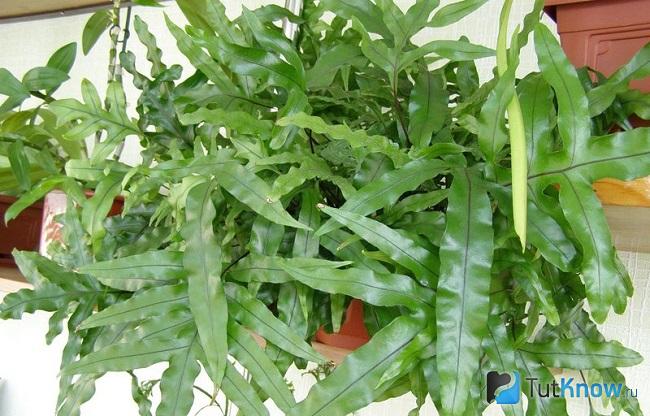

- Lighting and location.
The plant feels good in bright light, but shaded from direct sunlight. A place on the window sill of the window "looking" to the east is suitable, in the western location up to 16 hours in the summer months it will be necessary to arrange shading from harmful ultraviolet radiation. A place is also suitable on the northern window, but then in winter you will need phytolamp illumination.
Air temperature when leaving
behind the fern, it should be roomy year-round, since the plant is thermophilic. In the spring and summer within 20-24 degrees, and in the autumn-winter months at least 16 units, optimally 18-20. With increasing temperatures, spraying is carried out more often.
Read also: Multi-flowered cotoneaster - features of growing the species
Fertilizers
polypodium should be applied from May to the end of summer days. Regularity - every 14 days. Use preparations for indoor decorative deciduous plants, the dosage is not exceeded.
Transplantation and reproduction of phlebodium
A fern transplant is required when the plant has grown so much that it does not fit into the old container. In this case, it is better to take a pot that is shallow, but wide in diameter, because the root system of the phlebodium grows in breadth. It is better to leave the roots with scales on the surface, which grew above the ground, without sprinkling them with a substrate.
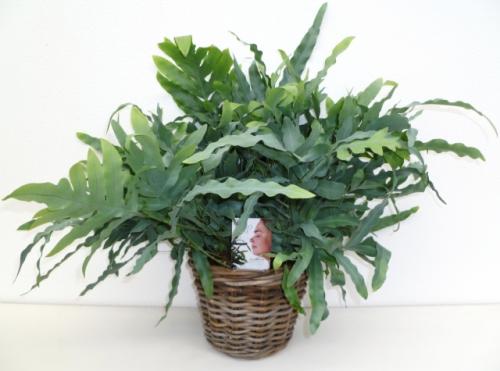

The optimal composition of the soil for further correct and comfortable growth of phlebodium is a ready-made mixture for ferns, loose and nutritious. After transplanting, the plant needs to be given increased attention, to monitor the moisture content of the soil.
Reproduction of phlebodium is possible by spores and division of the rhizome. Growing a plant from small spores is a long and troublesome process, so most growers prefer the second method. You need to divide the root carefully and carefully so as not to damage the young shoots. Even small areas of the rhizome can be planted and a full-fledged fern can be grown, if you make an effort and give the flower the right attention.
Phlebodium is an unusual tropical plant, and at home it looks bright and stands out from other flowers. And by providing him with the necessary care, you can achieve a large and beautiful fern growth.
Excerpt from Phlebodium golden
There was no room in the upper rooms of the inn: everyone was busy. Pierre went into the courtyard and, having covered his head, lay down in his carriage. As soon as Pierre lay his head on the pillow, he felt that he was falling asleep; but suddenly, with the clarity of almost reality, there was a boom, a boom, a boom of shots, there were moans, screams, the splashing of shells, there was a smell of blood and gunpowder, and a feeling of horror, fear of death seized him. Frightened, he opened his eyes and raised his head from under his greatcoat. Everything was quiet outside. Only at the gate, talking with the janitor and splashing in the mud, was some orderly walking. Above Pierre's head, under the dark seamy side of the canopy, the doves startled from the movement that he made, getting up. Throughout the courtyard, the strong smell of an inn, the smell of hay, manure and tar, was spread, peaceful for Pierre at that moment. A clear starry sky was visible between the two black awnings. “Thank God that this is no more,” thought Pierre, closing his head again. - Oh, how terrible the fear and how shamefully I surrendered to it! And they ... they were all the time, to the end were firm, calm ... - he thought. In Pierre's understanding, they were soldiers - those who were on the battery, and those who fed him, and those who prayed to the icon. They - these strange, hitherto unknown to him, clearly and sharply separated in his thoughts from all other people.“Be a soldier, just a soldier! Thought Pierre, falling asleep. - To enter this common life with the whole being, to be imbued with what makes them so. But how can one throw off all this superfluous, diabolical, all the burden of this external person? At one time I could be this. I could run from my father as I wanted. After the duel with Dolokhov, I could have been sent as a soldier. " And in Pierre's imagination there was a flash of dinner at the club, where he summoned Dolokhov, and the benefactor in Torzhok. And now Pierre is presented with a solemn dining box. This lodge takes place in the English club. And someone familiar, close, dear, sits at the end of the table. Yes, it's him! This is a benefactor. “Why, he's dead? Thought Pierre. - Yes, he died; but I didn't know he was alive. And how sorry I am that he died, and how glad I am that he is alive again! " On one side of the table sat Anatol, Dolokhov, Nesvitsky, Denisov and others like that (the category of these people was as clearly defined in Pierre's soul in a dream as the category of those people whom he called them), and these people, Anatol, Dolokhov they shouted and sang loudly; but from behind their cry the benefactor's voice was heard, incessantly speaking, and the sound of his words was as significant and continuous as the rumble of a battlefield, but it was pleasant and comforting. Pierre did not understand what the benefactor was saying, but he knew (the category of thoughts was just as clear in a dream) that the benefactor was talking about good, about the possibility of being what they were. And they from all sides, with their simple, kind, firm faces, surrounded the benefactor. But although they were kind, they did not look at Pierre, did not know him. Pierre wanted to draw their attention to himself and say. He got up, but at the same instant his legs became cold and bared. He felt ashamed, and he covered his legs with his hand, from which the greatcoat had really fallen off. For a moment Pierre, straightening his overcoat, opened his eyes and saw the same awnings, pillars, courtyard, but all this was now bluish, light and covered with sparkles of dew or frost. “It’s dawning,” thought Pierre. - But that's not it. I need to listen to and understand the words of the benefactor. " He again covered himself with his greatcoat, but neither the dining-box nor the benefactor was already there. There were only thoughts clearly expressed in words, thoughts that someone said or Pierre himself changed his mind. Pierre, recalling these thoughts later, in spite of the fact that they were caused by the impressions of that day, was convinced that someone outside of him had spoken them to him. Never, as it seemed to him, he in reality was not able to think so and express his thoughts. “War is the most difficult submission of human freedom to the laws of God,” said the voice. - Simplicity is obedience to God; you can't get away from him. And they are simple. They do not speak, but they do. The spoken word is silver, and the unsaid is golden. A person cannot possess anything while he is afraid of death. And whoever is not afraid of her, he owns everything. If there were no suffering, a person would not know his own boundaries, would not know himself. The most difficult thing (Pierre continued to think or hear in his sleep) is to be able to combine the meaning of everything in his soul. Connect everything? - Pierre said to himself. - No, don't connect. It is impossible to connect thoughts, but to combine all these thoughts - that's what you need! Yes, you need to pair, you need to pair! - Pierre repeated to himself with inner delight, feeling that by these, and only by these words, what he wants to express is expressed, and the whole question tormenting him is resolved. - Yes, you need to pair, it's time to pair. - You need to harness, it's time to harness, your Excellency! Your Excellency, - a voice repeated, - we need to harness, it's time to harness ... It was the voice of the bereader, waking Pierre. The sun was beating right in Pierre's face. He glanced at the filthy inn, in the middle of which, near the well, soldiers were giving water to thin horses, from which carts drove out through the gate. Pierre turned away with disgust and, closing his eyes, hurriedly fell back onto the seat of the carriage. “No, I do not want this, I do not want to see and understand this, I want to understand what was revealed to me during my sleep. One more second, and I would have understood everything.What am I to do? Match, but how to match everything? " And Pierre felt with horror that all the meaning of what he saw and thought in a dream had been destroyed. The driver, coachman and janitor told Pierre that an officer had arrived with the news that the French had moved under Mozhaisk and that ours were leaving. Pierre got up and, having ordered to lay and catch up with himself, went on foot through the city. The troops left and left about ten thousand wounded. These wounded were seen in the courtyards and in the windows of houses and crowded in the streets. In the streets near the carts that were supposed to take away the wounded, shouts, curses and blows were heard. Pierre gave the carriage that overtook him to a wounded general he knew and drove with him to Moscow. Dear Pierre learned about the death of his brother-in-law and about the death of Prince Andrew. On the 30th, Pierre returned to Moscow. Almost at the outpost he met Count Rostopchin's adjutant. “We’re looking for you everywhere,” said the adjutant. “The Count must see you by all means. He asks you to come to him at once on a very important matter. Pierre, without stopping home, took a cab and went to the commander-in-chief. Count Rostopchin only this morning arrived in the city from his country cottage in Sokolniki. The hallway and reception room in the count's house were full of officials who appeared at his request or for orders. Vasilchikov and Platov had already seen the count and explained to him that it was impossible to defend Moscow and that it would be surrendered. Although this news was concealed from the inhabitants, the officials and heads of various directorates knew that Moscow would be in the hands of the enemy, just as Count Rostopchin knew it; and all of them, in order to relinquish responsibility, came to the commander-in-chief with questions about what to do with the units entrusted to them. While Pierre was entering the reception room, a courier from the army left the count. The courier waved his hand hopelessly at the questions that were asked of him and walked through the hall. While waiting in the waiting room, Pierre looked with tired eyes around the various, old and young, military and civilian, important and unimportant officials who were in the room. Everyone seemed unhappy and restless. Pierre approached a group of officials, one of which was his acquaintance. Having greeted Pierre, they continued their conversation.
Polypodium fern care.
Lighting.
Domestic fern prefers bright, diffused lighting. Growing on the west or east window is favorable. In cloudy autumn-winter times, the polypodium needs artificial lighting up to 8 hours a day.
Temperature.
Spring-summer: +22, +25 degrees.
Autumn-winter: + 15, + 18 degrees.
Polypodium is sensitive to cold and drafts. Insulate the windowsills for the winter and remove the pot from the window when ventilating in the winter.
Humidity.
Polypodium can be washed periodically under the shower. This plant is ideal for keeping in glass terrariums.
The polypodium is watered with care. This plant does not tolerate both waterlogging and overdrying of the substrate. The topsoil should dry out between waterings. Water must be defended.
Top dressing.
You can feed the polypodium with liquid fertilizers for ferns, or with conventional fertilizers for decorative deciduous plants. Top dressing is applied from March to October according to the manufacturer's instructions.
Transfer.
The home fern is transplanted as the pot is filled with roots. Only a few months are suitable for transplanting - from the end of February to May. Ready-made substrates for epiphytes are suitable for planting a plant. You can prepare soil from leafy, coniferous soil, humus, peat, sand (2: 1: 1: 1).
A fern pot requires a wide, voluminous one. A thick layer of drainage should be poured onto the bottom of the pot.
Reproduction.
The polypodium reproduces by divisions.To do this, cut off a part of the bush of an adult plant during transplantation, process the cut with crushed coal and immediately plant the cut part of the plant in a new pot. In a warm, slightly shaded place, the delenka soon takes root and starts growing.
Pests.
Indoor ferns are usually parasitized by scale insects and spider mites.
Photo of the polypodium.
Polypodium vulgare Common centipede

